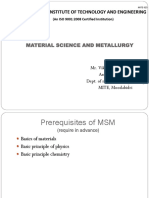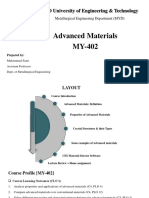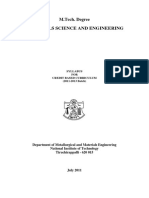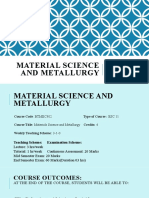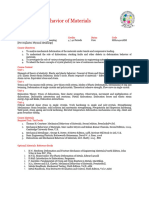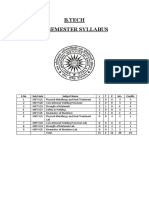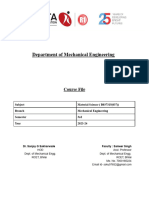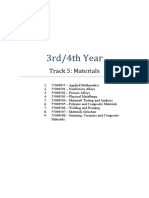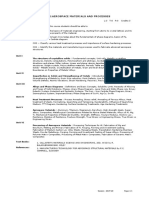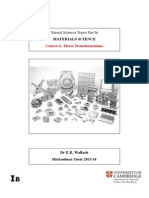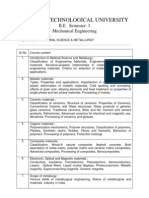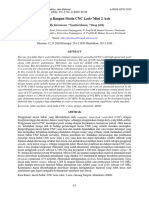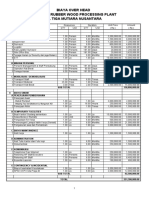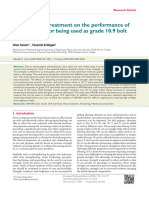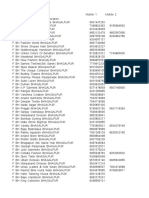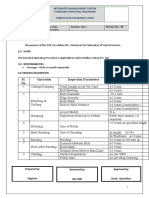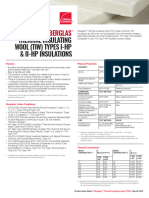1 TH
1 TH
Uploaded by
Aditya TOriginal Description:
Original Title
Copyright
Available Formats
Share this document
Did you find this document useful?
Is this content inappropriate?
Report this DocumentCopyright:
Available Formats
1 TH
1 TH
Uploaded by
Aditya TCopyright:
Available Formats
Agenda Item 65/46 - Annexure - 42
BMEE209L Materials Science and Engineering L T P C
3 0 0 3
Pre-requisite BPHY101L , BPHY101P , BCHY101L , BCHY101P Syllabus version
1.0
Course Objectives
1. To impart knowledge on the correlation between structure-property of materials.
2. To provide knowledge on mechanical properties of materials and strengthening
mechanisms.
3. To give insight into advanced materials such as polymers, ceramics and composites
and their applications.
Course Outcomes
At the end of the course, the student will be able to
1. Compare different structures based on the atomic arrangement.
2. Examine various phases of metals and alloys using phase diagrams.
3. Assess the mechanical behaviour of materials according to the standards.
4. Recommend suitable heat treatment and surface hardening processes.
5. Propose the suitable material based on the structure-property relationships.
Module:1 Fundamentals to Materials engineering 3 hours
Historical perspective of materials, materials science, Materials engineering, Materials
classification, Materials tetrahedron, Engineering requirement of advanced materials and
smart materials – Diversified applications.
Module:2 Crystallography and Defects 6 hours
Fundamental Concepts, Crystal geometry, Unit Cell, Classification of Lattices – Bravais
Lattice - Point coordinates, Crystallographic Directions and Planes, Weiss zone law
applications - Single and Poly crystalline materials, Non-crystalline/Amorphous Materials.
Crystal Structure of Metals, Ceramics and Polymers, Defects in crystals – point defects, line
defects (dislocations), Characteristics of Dislocations, Slip Systems, Slip in Single Crystal,
Deformation by Twining, surface defects and volume defects, Microscopic examination.
Module:3 Solidification, Diffusion and Phase Transformation 8 hours
Nucleation - Homogeneous and Heterogeneous Nucleation- Growth of crystals- Planar
growth – dendritic growth. Diffusion: Introduction – Fick’s Law of Diffusion - Diffusion
Mechanisms, Steady state and non-steady state diffusion. Basics of phase diagram, Gibb’s
phase rule, Lever rule, Unary phase Diagrams, Binary Isomorphous and Eutectic Systems,
Interpretation of Phase Diagram, Iron – iron carbide phase diagram – Slow cooling of hypo
and hyper eutectoid steels, Phase transformations in steels and cast iron.
Module:4 Mechanical behaviour of Materials 7 hours
Hardness Testing of Materials, Tensile properties of the materials, Effect of strain rate,
Impact Testing, Fracture of Metals – Ductile Fracture, Brittle Fracture, Ductile to Brittle
Transition Temperature (DBTT), Fatigue – Endurance limit, Fatigue test, S-N curves, factors
affecting fatigue, structural changes accompanying fatigue; Creep and stress rupture–
mechanism of creep – stages of creep and creep test, Mechanisms of Strengthening in
Metals and alloys.
Module:5 Heat Treatment 7 hours
Isothermal Transformation diagrams and Continuous Cooing Transformation diagram.
Principles of heat treatment, Annealing, Concept of Recovery, Recrystallization and Grain
Growth, Normalizing, Hardening, Tempering, Solutionizing, Ageing, Special heat treatment
processes: Austemepering, Martempering, Ausforming, Hardenability of steel, Microstructure
changes during heat treatment.
Surface hardening processes - Carburizing – Nitriding – Cyaniding and carbo-nitriding,
Induction and flame hardening, Laser and Electron beam hardening.
Module:6 Metallic Materials 6 hours
Steels – Types of Steels, Effect of alloying elements on structure and properties of steels,
Proceedings of the 65th Academic Council (17.03.2022) 1305
Agenda Item 65/46 - Annexure - 42
Alloy Steel – Tool and Die Steel, Stainless steel, Speciality steel, Cast iron- White, Grey,
Malleable and Nodular - Properties and application of cast irons. Non-ferrous Alloys,
Aluminium, copper, Nickel, Magnesium and Titanium.
Module:7 Non-metallic and Composite Materials & Economic, 6 hours
Environmental, and societal issues in materials Science and
Engineering
Ceramics: types, properties and application of ceramics; Glass: classification of glass,
properties and application of glass; Polymer: classification of polymers - properties and
application of polymers; Fibers: Natural Fibers/Synthetic Fibers; Composites: Classification
of Composite Materials, Properties and Application of Composite Materials.
Module:8 Contemporary Issues 2 hours
Total Lecture hours: 45 hours
Text Books
1. William D. Callister Jr., David G. Rethwisch, Callister's Materials Science and
Engineering, 2018, 10th edition, John Wiley & Sons, Inc., United states.
2. William F Smith, Javad Hasemi and Ravi Prakash, Materials science and
Engineering, 2017, 5th edition, McGraw Hill Publications.
Reference Books
1. Michael F. Ashby, Materials Selection in Mechanical Design, 2016, 5th edition, Elsevier
Butterworth-Heinemann.
2 Donald R. Askeland, Science and Engineering of Materials, SI Edition, 2015, 7th edition,
Springer, Boston, MA.
3 Raghavan V, Materials Science and Engineering, 2015, 6th edition, Prentice Hall India
Learning Private Limited, United Kingdom.
4 Sidney Avner, Introduction to Physical Metallurgy, 2017, 2nd edition, McGraw Hill
Education
Mode of Evaluation: CAT / Written assignment / Quiz / FAT
Recommended by Board of Studies 09-03-2022
Approved by Academic Council No. 65 Date 17-03-2022
Proceedings of the 65th Academic Council (17.03.2022) 1306
You might also like
- Fuel Cell Technology SyllabusDocument3 pagesFuel Cell Technology SyllabusArun EbenezerNo ratings yet
- Bmee209l Materials-science-And-Engineering TH 1.0 67 Bmee209lDocument3 pagesBmee209l Materials-science-And-Engineering TH 1.0 67 Bmee209lKrijayNo ratings yet
- Course Plan: Department of Mechanical EngineeringDocument12 pagesCourse Plan: Department of Mechanical EngineeringMalagouda PatilNo ratings yet
- Applied MaterialsDocument3 pagesApplied Materialsshashank raj kumarNo ratings yet
- PHRE 415 - Metallurgy and Workshop PracticesDocument2 pagesPHRE 415 - Metallurgy and Workshop Practicesasphaltnoob8No ratings yet
- Material Science SyllabusDocument2 pagesMaterial Science Syllabus1DA20ME023 Girish M BNo ratings yet
- Mangalore Institute of Technology and Engineering: Material Science and MetallurgyDocument203 pagesMangalore Institute of Technology and Engineering: Material Science and MetallurgyNISHAANTH S 1861462No ratings yet
- Me209 Mechanical Properties of Structural Materials PDFDocument4 pagesMe209 Mechanical Properties of Structural Materials PDFjishnuNo ratings yet
- Note For Introduction To Materials MST 510Document147 pagesNote For Introduction To Materials MST 510Khairul BarsriNo ratings yet
- Engineering MaterialsDocument2 pagesEngineering MaterialsRïtämPäl100% (1)
- MEE1005 Materials Engineering and Technology: Lecture - 1Document21 pagesMEE1005 Materials Engineering and Technology: Lecture - 1Aashna ChopraNo ratings yet
- Emt 2132 Introduction To Material Science PDFDocument52 pagesEmt 2132 Introduction To Material Science PDFStephanie MirañyiNo ratings yet
- Module-1 AM PDFDocument46 pagesModule-1 AM PDFbilal hasanNo ratings yet
- Cruystal Structure CHP 1Document23 pagesCruystal Structure CHP 1pavanvasanth kommineniNo ratings yet
- M&MSDocument2 pagesM&MSASIST MechNo ratings yet
- Mtech Mme Materials Science 2012 13Document19 pagesMtech Mme Materials Science 2012 13Anonymous sENwj8nwqNo ratings yet
- AM Material ScienceDocument4 pagesAM Material ScienceTushar Mani AgarwalNo ratings yet
- 3.1 Material ScienceDocument12 pages3.1 Material Sciencepuneet375No ratings yet
- 14.materials Science and Engineering PDFDocument18 pages14.materials Science and Engineering PDFs_manikandanNo ratings yet
- Material Science and MetallurgyDocument10 pagesMaterial Science and MetallurgysrujankalaNo ratings yet
- 4th Semester SyllabusDocument8 pages4th Semester Syllabus006KAbhishek KumarNo ratings yet
- Btech Syllabus 4th Semester PDFDocument11 pagesBtech Syllabus 4th Semester PDFAmAn DeEpNo ratings yet
- Course Work Material ScienceDocument29 pagesCourse Work Material ScienceSameer SinghNo ratings yet
- II Year Emm Edited PDFDocument91 pagesII Year Emm Edited PDFMECHANICAL SMCETNo ratings yet
- Engineering Chemistry Syllabus 2020 21Document4 pagesEngineering Chemistry Syllabus 2020 21cat buenafeNo ratings yet
- MET311E Physical MetallurgyDocument2 pagesMET311E Physical MetallurgySaúl L Hdez TNo ratings yet
- Chemistry Notes VtuDocument160 pagesChemistry Notes VtuNarayan S. Burbure67% (3)
- Arunya: Institute of Technology and SciencesDocument2 pagesArunya: Institute of Technology and SciencesvijayNo ratings yet
- Final Version of 5-8 Sem Detailed Scheme - Syllabus MME NIT RaipurDocument76 pagesFinal Version of 5-8 Sem Detailed Scheme - Syllabus MME NIT RaipurprashantjnvlkhNo ratings yet
- CHEMISTRY Course FileDocument32 pagesCHEMISTRY Course FileRangothri Sreenivasa SubramanyamNo ratings yet
- Ceramic Tech SyllabusDocument36 pagesCeramic Tech SyllabusvishwanathanskNo ratings yet
- Syallabus PH 8251 Material ScienceDocument2 pagesSyallabus PH 8251 Material ScienceAkhil KumarNo ratings yet
- AU 3rd SEM - AU 2023-24030823012842Document11 pagesAU 3rd SEM - AU 2023-24030823012842badalmewada2002No ratings yet
- 1.material and MetallurgyDocument28 pages1.material and MetallurgyHakimi BobNo ratings yet
- Engineering MaterialDocument2 pagesEngineering Materialultimatestatus2279No ratings yet
- Material Science and Metallurgy PDFDocument1 pageMaterial Science and Metallurgy PDFSanjay GomastaNo ratings yet
- Material Science PDFDocument183 pagesMaterial Science PDFSalma IqbalNo ratings yet
- Advanced Materials and Processes: Course OutlineDocument1 pageAdvanced Materials and Processes: Course OutlineSebastián Díaz ConstanzoNo ratings yet
- 7th Sem SyllabusDocument6 pages7th Sem SyllabusAshwit KumarNo ratings yet
- 3321902Document8 pages3321902Er Mishal GandhiNo ratings yet
- 4.1 Materials and MetallurgyDocument16 pages4.1 Materials and MetallurgyVijayKumarNo ratings yet
- Materials Science and EngineeringDocument1 pageMaterials Science and EngineeringAnkit PaliwalNo ratings yet
- MukeshDocument22 pagesMukeshVikram NikhilNo ratings yet
- Chap 1Document28 pagesChap 1ALIYAN ALINo ratings yet
- 3rd/4th Year: Track 5: MaterialsDocument19 pages3rd/4th Year: Track 5: MaterialsAnas Sebtu PrawiraNo ratings yet
- Materials Testing and Characterization TechniquesDocument1 pageMaterials Testing and Characterization TechniquesdsathiyaNo ratings yet
- Lesson Plan: Page 1 of 6 Unit: I Branch: B.E. Mechanical Engg. Semester: IVDocument6 pagesLesson Plan: Page 1 of 6 Unit: I Branch: B.E. Mechanical Engg. Semester: IVDinesh Kumar R100% (1)
- Ase102:Aerospace Materials and Processes: Session 2019-20 Page:1/1Document1 pageAse102:Aerospace Materials and Processes: Session 2019-20 Page:1/1Yashwanth Krishna GampaNo ratings yet
- Material Science and Metallurgy PDFDocument1 pageMaterial Science and Metallurgy PDFGopi KrishnaNo ratings yet
- New Syllabus With Code Revised 2017Document1 pageNew Syllabus With Code Revised 2017Senthil Kumar PNo ratings yet
- AHDocument114 pagesAHReyza PrasetyoNo ratings yet
- Echmsyll PDFDocument8 pagesEchmsyll PDFashishNo ratings yet
- Materia Engineering Cha 1Document236 pagesMateria Engineering Cha 1amanuelfitsum589No ratings yet
- Material Science & MetallurgyDocument2 pagesMaterial Science & Metallurgyshekhadaa60% (5)
- Engineering Chemistry IDocument5 pagesEngineering Chemistry Isenthil kumaran mNo ratings yet
- ME309 Metallurgy and Material Science PDFDocument4 pagesME309 Metallurgy and Material Science PDFPremnath G100% (1)
- Metallurgy Unlocked Mastering Metallurgical Diploma Questions and AnswersFrom EverandMetallurgy Unlocked Mastering Metallurgical Diploma Questions and AnswersNo ratings yet
- MTI Assignment - Antesh Kumar - EPGP-13A-021Document8 pagesMTI Assignment - Antesh Kumar - EPGP-13A-021Antesh SinghNo ratings yet
- Rancang Bangun Mesin CNC Lathe Mini 2 Axis: Eddy Kurniawan, Syaifurrahman, Bong JekkyDocument8 pagesRancang Bangun Mesin CNC Lathe Mini 2 Axis: Eddy Kurniawan, Syaifurrahman, Bong JekkyThomas RandolphNo ratings yet
- Pre-Assessment of 3Dprinting-Teacher VersionDocument3 pagesPre-Assessment of 3Dprinting-Teacher VersionDhirenNo ratings yet
- Focus On The Fundamentals of Shielded MV Power CableDocument3 pagesFocus On The Fundamentals of Shielded MV Power CableMrNo ratings yet
- Tds Dura-Pure sn95-sb5Document1 pageTds Dura-Pure sn95-sb5agus sutiawanNo ratings yet
- Training Report On Bokaro Steel Plant - Common Electrical DoubtsDocument46 pagesTraining Report On Bokaro Steel Plant - Common Electrical DoubtsSanjay kumarNo ratings yet
- UK Bolt SizesDocument26 pagesUK Bolt SizesVincent ChuNo ratings yet
- 1 s2.0 S1350630716303624 MainDocument12 pages1 s2.0 S1350630716303624 MainRafaella SilvaNo ratings yet
- G CodesDocument3 pagesG CodesSahil TanweerNo ratings yet
- 4.2 Industrial Revolution, HiB&US Lecture WorksheetDocument1 page4.2 Industrial Revolution, HiB&US Lecture WorksheetAdrien BaziretNo ratings yet
- Biaya Over Head Project: Rubber Wood Processing Plant Pt. Tiga Mutiara NusantaraDocument126 pagesBiaya Over Head Project: Rubber Wood Processing Plant Pt. Tiga Mutiara NusantaraEric YohantaNo ratings yet
- Trim Ste PDFDocument4 pagesTrim Ste PDFSTE TSCNo ratings yet
- Lecture 8 - Rotary Ultrasonic MachiningDocument20 pagesLecture 8 - Rotary Ultrasonic MachiningAbdulrahman goudaNo ratings yet
- E Waste Related CommunicationDocument3 pagesE Waste Related CommunicationAkanksha GoelNo ratings yet
- Effect of Heat Treatment On The Performance of 30MnB4 Steel For Being Used As Grade 10.9 BoltDocument6 pagesEffect of Heat Treatment On The Performance of 30MnB4 Steel For Being Used As Grade 10.9 Boltkim983124No ratings yet
- CSS12 1st WEEK7 SSLM EvaluatedDocument5 pagesCSS12 1st WEEK7 SSLM EvaluatedAlberth Rodillas AbayNo ratings yet
- EPAL Gitterbox Specification PalletBizDocument2 pagesEPAL Gitterbox Specification PalletBizPauliusNo ratings yet
- Tolerances and Fits: Min MaxDocument24 pagesTolerances and Fits: Min MaxIrfan MuhammadNo ratings yet
- BHAGALPURDocument5 pagesBHAGALPURTanya SinghNo ratings yet
- Paper 13: Turbo Pulp Lifter (TPL) - An Efficient Discharger To Improve SAG Mill PerformanceDocument12 pagesPaper 13: Turbo Pulp Lifter (TPL) - An Efficient Discharger To Improve SAG Mill Performance1978ECRNo ratings yet
- DS 60-Typ-Separator Rev.3.2 ENDocument3 pagesDS 60-Typ-Separator Rev.3.2 ENAttila HontváriNo ratings yet
- Code Description Unit Quantity Rate AmountDocument2 pagesCode Description Unit Quantity Rate AmountVikas JangidNo ratings yet
- Design Load Basis Report Tensile Canopy - Vedvan - Noida - R0Document27 pagesDesign Load Basis Report Tensile Canopy - Vedvan - Noida - R0Neeraj KumarNo ratings yet
- Sr. No. Operation Inspection Parameters Tolerances: 1.0 PurposeDocument2 pagesSr. No. Operation Inspection Parameters Tolerances: 1.0 PurposeSwarup SontakkeNo ratings yet
- Sae Ams 2759-3H-2019Document20 pagesSae Ams 2759-3H-2019Reza NooriNo ratings yet
- LAB SESSION NO 3 Material and ManufacturingDocument9 pagesLAB SESSION NO 3 Material and Manufacturingm.sheraz malikNo ratings yet
- Psguide 2015Document83 pagesPsguide 2015laacostam93No ratings yet
- Fiberglas TIWA Product Data SheetDocument2 pagesFiberglas TIWA Product Data SheetRangaswamy DoraiswamyNo ratings yet
- Steel Castings, General Requirements, For Pressure-Containing PartsDocument16 pagesSteel Castings, General Requirements, For Pressure-Containing PartsEdmilson FaustinoNo ratings yet
- CBB Ts 161128 Babbitt TypesDocument1 pageCBB Ts 161128 Babbitt TypesAlejandro SanchezNo ratings yet







